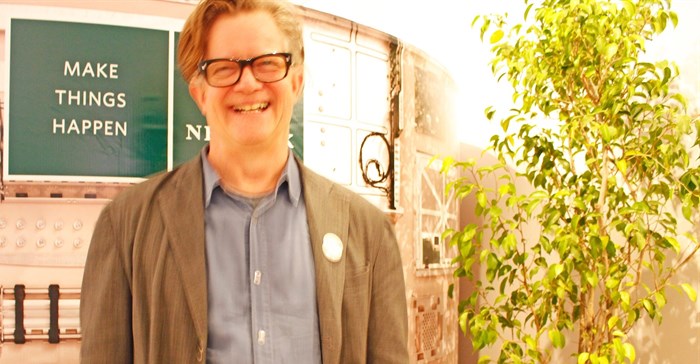Trending
[Design Indaba 2016] Never never land
But, never, never, has storytelling taken on so vital a role as in the hand of Design Indaba speaker Alex McDowell, creative director of LA-based 5D Studios, a company at the epicentre of design, tech and disruptive storytelling.

One, but by no means the only of McDowell’s claims to fame, is the futuristic scenarios he created for Steven Spielberg’s award-winning 1999 film Minority Report, but more about that later...
Actually, his career path itself reads a little bit like a sci-fi plot. As social secretary of The Central School of Art in London in 1974, the job of booking bands for gigs fell to him and his best friend Sebastian Conran, son of former Design Indaba keynote speaker and uber-entrepreneur, Sir Terence Conran.
The pope of pop culture
As the story goes, a guy came up to Alex outside the art school and said something like “Oi, do you want a band to play for free tomorrow night?”
Responding with the only possible answer of 'yes', begat none other than the Sex Pistols first headline gig, the birth of punk rock proper and the wheels set in motion for all manner of mayhem down at Central, including a complete change in directional style for McDowell and other students, with artworks being ripped up and torn down by lecturers and new collaborations forged with future icons such as Vivienne Westwood, Vogue Art Director Terry Jones, the launch of the disruptive punk iD magazine and the formation of Rocking Russian Design Studio in collaboration with ex-Pistols member Glen Matlock, which also ensured the first job for a young Neville Brody.
Neville is apparently on record as saying it was the most chaotic place he has ever worked in, in those glory days of designing album covers and music videos for punk groups such as Siouxsie and the Banshees, The Clash, The Cure and others, in a series if events which saw ultimately saw McDowell relocate permanently to LA to work in the burgeoning music video and commercials industry.
In collaboration with David Fincher, designer of Chuck Palahniak’s Fight Club, video campaigns for Iggy Pop followed, paving the way for another 30 years of McDowell’s work in film. There sure is lot of pop culture to catch up on, isn’t there, poppets?
The story of stories
McDowell continues with the story of stories themselves. Of tribes around the fire, how physical reality became myth and metaphor to us humans, the silver disc in the sky, the princess moving across the sky, or whatever. Making sense, creating a human code, the giant mythologies of the Greeks and Romans, in his opinion, were disrupted by the printing press and the point when storytelling started to shift to religious authorities, which led to singular instead of the collective story tellers.
He describes the new media as having moved again from linear narrative to spherical space, an entire world space - the biggest disruption since the invention of cinema, “the tribal space is back in our hands and probably just at the right moment”.
McDowell speaks of “world building as a design practice” and how narrative is embedded in the world around us and is where his current story begins.
Imagining 2050 in 1999
In 1999, McDowell was tasked to imagine what the future reality of the year 2050 would look like in the forthcoming Steven Spielberg movie, Minority Report. As there was as yet no script (scriptwriter Scott Frank having been commissioned on the same day), the process began with the highest level scientific research - what urban planning, data, biomimicry and mobility might look like in the future.
Around this time, the first practitioners of 3D animation and modelling technologies such as CAD and Maya were also starting to emerge. And so with the design of the film preceding its story, a truly visionary environment, and one which in retrospect looks quite a lot like a blueprint for Indaba speaker Alfredo Brillembourg’s vertical cities and elevator transportation, was created.
By the way, all those gestural movements that you see in Minority Report were created by John Underkoffler, whose platforms, according to McDowell, are currently in use by no less that 50 of the world’s Fortune 500 companies. Click here for more.
Poverty is a social construct
A real-life application of imagined virtual futures, can be seen in McDowell’s Al Baydha case study, whereby an impoverished Bedouin tribe in Saudi Arabia is currently in the process of inhabiting and interacting within a 3D virtual model of a future environment, which allows this otherwise illiterate community full immersion in a new “story space”, able to educate and test the viability of things like harnessing water from flash floods, agricultural ecosystems, sustainable energy, healthcare and telecommunications – embracing high and low tech typologies and elegantly demonstrating how virtual worlds may be used in the creation of future realities.
As McDowell so neatly puts it, “I have no specific interest in VR, but it gives you a level of access that you can’t get any other way”, adding, “we are only scratching the surface of what storytelling can be”.
Terry Levin has been covering Design Indaba for 12 years for proud media partner Bizcommunity.




















